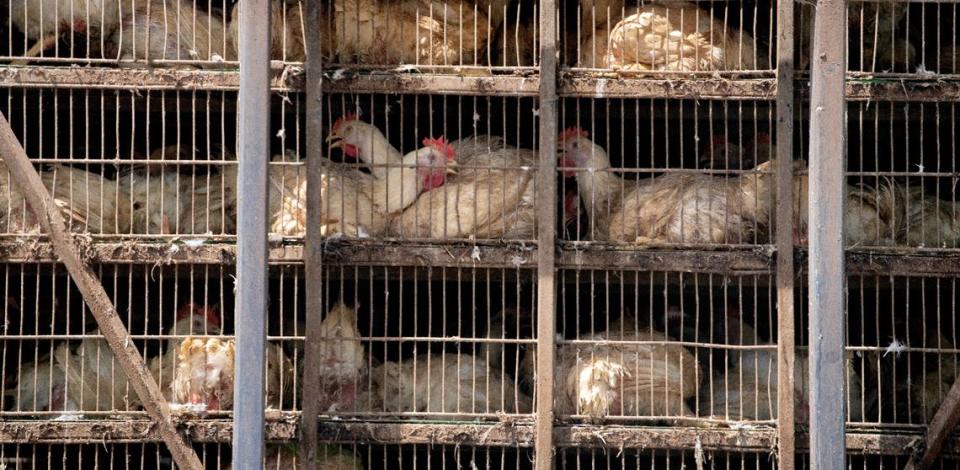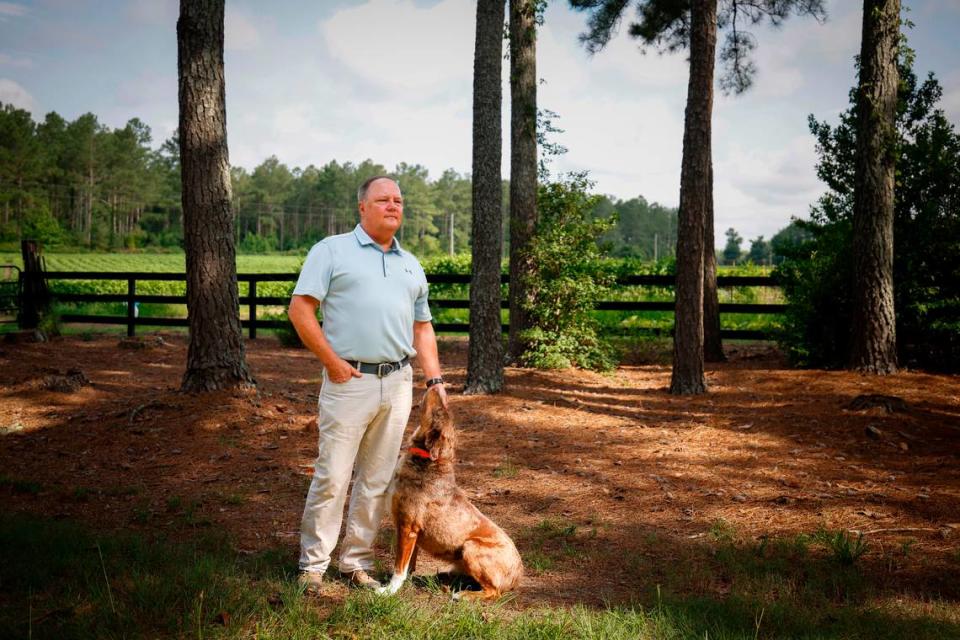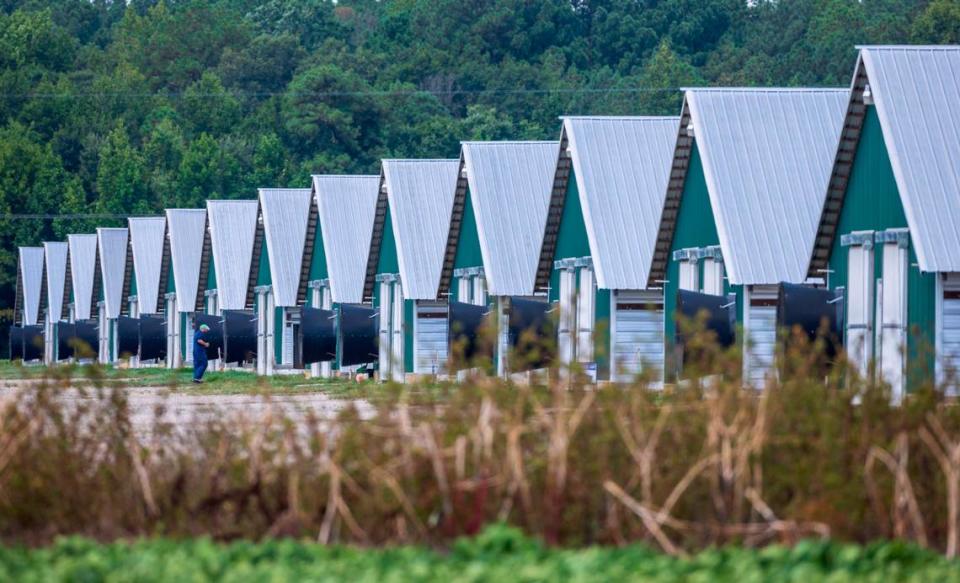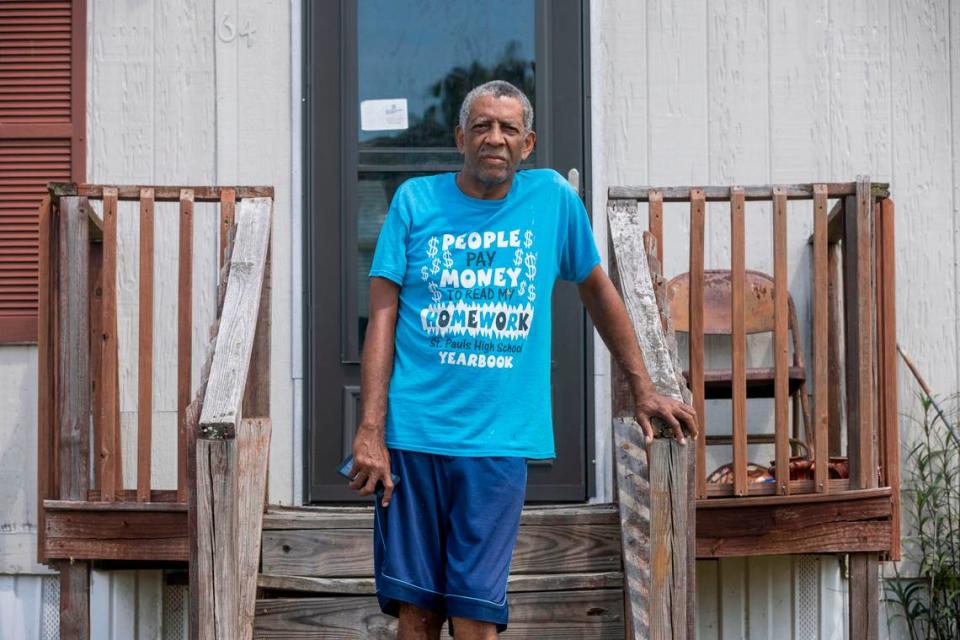With no power to fend off poultry farms, neighbors live with stench and nuisances
Editor's note: Viewing this story in our app? Click here for a better experience on our website.
There are days when John Griffin catches an odor so strong he’ll examine the sole of his shoes, just to see if he has stepped in dog poop.
Then he remembers: He lives near a chicken farm.
“The stench is oppressive,” the Surry County retiree says. “It’s a lot like dog mess and vomit.”
More North Carolina residents are finding themselves neighbors to massive poultry farms that produce odors, noxious dust and hundreds of tons of manure.
About 230,000 North Carolinians now live within a half mile of a poultry farm, an analysis by The Charlotte Observer and News & Observer shows. Interviews and aerial photos suggest more barns — massive structures that can hold up to 40,000 chickens apiece — may be coming.
Industry leaders say farmers and poultry companies work hard to protect those who live near barns, noting that they’ve put in place voluntary setbacks designed to ensure farms aren’t built too close to homes.
“We want to be a good neighbor,” said Bob Ford, executive director of the N.C. Poultry Federation.
But in a state where officials have shielded the poultry industry from lawsuits, regulation and public disclosure, there is practically nothing residents can do to protect themselves from the stench, the vultures or anyone’s plan to build more barns.
Local governments can’t help them. Nor, in most cases, can the state. Even the ability to file lawsuits has been limited, thanks to recent legislative changes that have weakened North Carolina’s nuisance laws.

A smelly transformation
Today, nearly a fifth of Anson County’s residents live within half a mile of a poultry farm, a Charlotte Observer and News & Observer analysis found.
Frank Lowery and his wife are among them. In the 1970s, Lowery and his wife bought a 21-acre plot surrounded by Anson County farmland 60 miles south of Charlotte. They moved into a double-wide home there in 1986.
Back then, they and their rural neighbors were surrounded by rolling fields of corn, soybeans and cotton along with groves of oaks and loblolly pines.

But in recent years, something new popped up: dozens of galvanized metal houses that stretch nearly the distance of two football fields — structures where contract farmers raise millions of chickens. The number of birds raised in the county has more than doubled over the past decade, state data shows.
Twenty four chicken barns were built about a half mile away from Lowery’s home over the past seven years. He and his wife now live with an assault on their senses: the overpowering smell of chicken waste, the frequent sounds of truck traffic, and the unsettling sight of turkey vultures that Lowery suspects arrive to feast on dead chickens.
Big Poultry: Part 1
North Carolina’s poultry industry has taken flight. Farms now stand near the mountains, the coast and the state’s largest cities. The birds generate billions of pounds of untreated waste – more than NC’s infamous hogs. But legislators cloak this industry in secrecy. What's the cost?
With little oversight, NC poultry farms raise 1 billion birds a year. Who pays the cost?
NC lawmakers have steadily changed rules, added protections to help poultry industry
Chickens produce billions of pounds of waste in NC. But no one is tracking it.
The package says the chicken is “free range.” That may not mean what you think.
On a typical poultry farm, disease, heat stress and other problems cause thousands of chickens to die each year. Many farmers compost the dead chickens, and that can prove attractive to scavengers.
“The buzzards are so bad, the sky is black with them sometimes,” said Lowery, 88, a retired textile worker.
Vultures can rid the landscape of deteriorating carcasses. But they also sometimes damage roof shingles and other property.
Lowery and his wife used to love the area. Now all the poultry farms make him feel like moving.
“If I didn’t have any family in Anson County, I’d be gone,” he said. “I’d try to find a place without chicken houses.”
Neighbors pay a price
In Anson, now home to more chickens and turkeys than all but two other North Carolina counties, many of Lowery’s neighbors say they know the feeling.
Johnny “Van” Garris and his wife have lived in southern Anson County for about 30 years. They used to enjoy spending time on their porch and in their yard, watching hummingbirds hover near their feeders or tending to the tomatoes, squash and cucumbers in their garden.
Two dozen poultry barns were built less than 2,000 feet from his home in recent years. Now the smell is sometimes so bad his wife refuses to come outside. Flies swarm. And turkey vultures occasionally cover the roof of their home.
Big poultry growth spurts
Three counties with significant growth in the number of poultry raised include Robeson, Anson and Duplin.

Robeson County
Anson County
Duplin County
96M
59M
47M
45M
28M
20M
2002
2021
2002
2021
2002
2021

Robeson County
45M
20M
2002
2021
Anson County
59M
28M
2002
2021
Duplin County
96M
47M
2002
2021
Source: N.C. Department of Agriculture and Consumer Services
Simply selling their home is easier said than done, Garris said. Because of all the nearby chicken houses, “I’m afraid the house wouldn’t be worth anything now,” he said.
Large-scale animal feeding operations can hurt the values of nearby homes, multiple studies have found.
More than 60 of the poultry houses that have cropped up in southern Anson County are owned by a single family. Vanessa Tran said in an interview that she immigrated from Vietnam in 1998 and raised chickens in Georgia before beginning to operate chicken houses in Anson County in 2014. Now, she, her brother and two of her sons own 64 poultry houses, where they raise chickens for Tyson Foods.
One of her sons, Huy Le, owns 16 of those 500-foot-long houses. “If the numbers make sense,” he said, “we’ll definitely build more.”
That’s what worries their neighbors.
Eddie Huntley and his family have owned land around his Anson County home since the 1800s, and now lease much of the acreage out to crop farmers.
When Huntley and his wife renovated their 1920s farmhouse house four years ago, they added a screened-in porch where they’d hoped to spend many an evening.
But within a mile of his house, dozens of poultry houses have popped up. One is within 50 feet of his property line. Now there are many nights when the smell of chicken manure keeps Huntley and his wife from their porch. Eating on the outdoor picnic table has also become untenable because of all the flies.

“I’m all about live and let live,” said Huntley, 62. “But they took away our quality of life.”
Tran and Le did not respond to multiple attempts to ask them about neighbors’ complaints.
Powerless to stop the farms
State rules require hog farms and a tiny number of poultry farms — those using liquid waste management systems — to take steps to control objectionable odors. But the overwhelming majority of poultry farms are exempt from those regulations.
And in North Carolina, local governments have virtually no say over where poultry farms are built.
When state legislators gave counties zoning powers in 1959, they decided that farming shouldn’t be subject to those rules.
A 2013 bill would have allowed counties to adopt zoning to govern some large-scale poultry farms — those designed to raise 150,000 or more birds. But the bill went nowhere.
An identical 2017 effort met the same fate.

Rep. Hugh Blackwell, a Burke County Republican who sponsored both bills, said he was seeking a middle ground between the concerns of neighbors and what the fast-growing industry needs to prosper, he said.
The proposed legislation had its roots in a 2012 argument between residents of the Hildebran area of Burke County and a family who wanted to build a four-barn chicken farm nearby.
Neighbors complained to county commissioners, who responded that they had no power over a chicken farm’s location despite neighbors’ concerns about their health and property values. But county commissioners did ask state legislators to grant them more control over poultry farm
Why did the bills fail?
Big Poultry: Part 2
Roughly 250,000 North Carolinians now live within a half mile of a poultry farm. If your family has lived on the same land for generations and one day a neighbor starts building big poultry barns, there is practically nothing you can do to protect yourself from the stink, buzzards and other nuisances that may soon float your way.
With no power to fend off poultry farms, neighbors live with stench and nuisances
North Carolina keeps poultry farm locations secret. We mapped them anyway.
Only NC says utilities must buy power fueled by poultry waste. Here’s the problem.
These neighbors kept a poultry farm from moving in. In NC, they’re the exception.
Lawmakers have tried to protect an industry that generates jobs, improves the economy and provides needed food, Blackwell said.
“We don’t want to kill the chickens that are going to lay the golden eggs,” Blackwell said.
Blackwell doesn’t plan to reintroduce the bill. “I don’t see a path forward,” he said.
Industry leaders say they try to minimize the impact of poultry farms on neighbors.
In 1994, the N.C. Poultry Federation adopted voluntary guidelines that said poultry houses should not be built closer than 500 feet to an occupied residence. In 2016, the federation revised those voluntary guidelines, increasing the minimum distance to 1,000 feet.
“We did that on our own, trying to make sure we didn’t have poison arrows thrown at us,” said Ford, the federation’s executive director. “ … The industry will try to control itself with stuff like that, so they feel like they’re doing the right thing.”

Most farmers who raise chickens and turkeys do so under contract with large companies, which control much of what happens inside their barns. Few of the companies doing business in North Carolina responded to questions about their efforts to protect those who live near poultry farms.
Mike Levengood, Chief Animal Care Officer and Farmer Relationship Advocate for Perdue Farms, did say that the company works with farmers to make sure they build their farms in locations that won’t create problems for those who live nearby.
“You want to be a good neighbor,” he said.
But when reporters interviewed more than 15 people who live near poultry farms in North Carolina, most said they felt the farms were still too close. Many questioned why public officials don’t try to stop farmers from building large-scale chicken houses near homes.
Residents affected by nearby poultry farms aren’t likely to get help from the courts, either. In 2018, the legislature passed a farm bill that sharply limits when neighboring property owners can file nuisance lawsuits against farms producing odors or other noxious conditions.

The law bars neighbors from obtaining punitive damages in court unless a farm was implicated in criminal convictions or government enforcement actions. It also prohibits people from filing lawsuits unless they live within half a mile of a farm. Those who want to sue also must act within a year of a farming operation starting or undergoing a “fundamental” change.
Changes in a farm’s ownership or size cannot be considered fundamental changes under the law. Nor can shifts in the type of agricultural products produced. Legislators have also capped damage awards in such lawsuits.
Huntley had hoped to renovate an 80-plus-year-old house on his Anson County property so that his daughter and mother-in-law could use it.
He hired a lawyer to try to stop the planned construction of poultry barns near the old house but that didn’t help. Today, he’s frustrated by the lack of protections for those who live near poultry farms.
“It’s like the Wild West,” he said.
Living with health worries
To some North Carolinians, nearby poultry houses represent more than just a nuisance; they are a potential health threat.
Large poultry barns are known to emit ammonia and other potentially harmful gases, along with dust that contains bits of manure, feed, feathers and other biological contaminants. Living close to large poultry operations may increase the risk of contracting pneumonia, a 2018 study conducted in Pennsylvania found.
Along a dirt road about 25 minutes south of Fayetteville, a powerful odor sometimes wafts from 48 chicken houses where farmers raise birds for Mountaire. Combined, these 600-foot-long houses can hold nearly 2 million chickens at a time. They are among the many poultry houses that have in recent years popped up in Robeson County, where the number of chickens and turkeys has increased almost six-fold over the past 30 years.

About a half mile away, in a quiet neighborhood of mobile homes, residents recounted how all those chickens have changed their lives.
Preston Fritz, 22, says that since those chicken houses went up about three years ago, he suffers from a runny nose, coughs and sneezing all year round. It’s so bad, he said, he can’t go outside without bringing tissues.
“The sneezing is all day,” he said.

He blames airborne particles that drift from the chicken barns.
“We need these farms because that’s where we’ll get our chicken,” Fritz said. “But they should move them away from where people live. It can’t be healthy.”
Jermie Locklear, a 52-year-old cabinet maker, said he has periodically suffered shortness of breath and other serious respiratory problems in recent years — all since a 20-barn poultry farm began operating less than half a mile away from his Robeson County home.
About five years ago, he was hospitalized for pneumonia. One of the first things the pulmonologist asked was whether he lived near a poultry or hog farm, he said.
“He said that could be a factor,” Locklear recalls.
Ashley Oxendine, the farmer who raises chickens near Locklear’s home, said he has worked hard to minimize nuisances from his farm.
Each year, he must clean out about 3,000 tons of chicken litter, a mixture of manure and poultry wood shavings used as bedding. Oxendine said he doesn’t store it outside his barns, but instead loads it into trucks for transport to farmers who spread it on fields for fertilizer. And he sprays poison around his barns three times a year to kill flies, he said.
“I go out of my way to be neighbor friendly,” said Oxendine, who raises chickens for Mountaire.
He disputes that his farm is getting anyone sick. “It’s hogwash,” he said.
Oxendine said he has been transporting poultry litter for 20 years — a job that sometimes causes litter to get in his nose, ears and mouth. Neither he nor any of the people he has worked with have gotten sick from it, he said.
Studies in several countries, however, have found an increased incidence of respiratory problems among poultry farm workers. As one review of research notes, such workers have an increased risk of developing respiratory problems “that may be attributed to exposure to dust and other airborne contaminants in poultry-house environments.”

‘We … got run over’
In South Carolina, farmers must notify residents living within a quarter mile if they intend to build a poultry operation. And the South Carolina Department of Health and Environmental Control posts notices around the perimeter of the property and on the agency’s website.
South Carolina also requires that farmers get an environmental permit — documentation that shows how they’ll protect area waterways — and submit to inspections at least once every four years.
North Carolina doesn’t require such notice for planned poultry farms. And except for a tiny percentage of farms using wet waste management systems, North Carolina’s industrial scale poultry farms don’t have to obtain environmental permits, which can require inspections. And environmental regulators don’t actively look for violations.
Asked about South Carolina’s rules, Ford, this state’s poultry federation director, said: “I don’t think we need to do anything we don’t have to do. Each state is different. South Carolinas has their way. We have our way.”
Stevie McMillan is troubled by North Carolina’s approach. About three years ago, 24 chicken houses were built near his small community of mobile homes in northern Robeson County. No one consulted residents before the chicken barns went up, McMillan said.
“We pretty much just got run over,” he said.’

Today, McMillan and his sister, Cynthia Wilson, live less than 1,500 feet away from the closest barns. Large trucks carrying feed and chickens regularly speed down the narrow two-lane roads near their homes, they say, and flies swarm in such numbers that they completely fill fly traps within two days.
Wilson, a retired hospital lab worker, said the odor sometimes comes through the vents and permeates the house where she has lived for 28 years.
She plugs in air fresheners to mask the odor. But some nights, she said, “I wake up and the smell is there.”
Hoping the winds will change
At her home in Surry County, northwest of Winston-Salem, Phyllis Jessup finds the smell is so strong she can sometimes taste it.
Jessup lives on an 80-acre farm, in a brick house that has been in her family for decades. In 2014, a longtime farmer built eight chicken barns on his land, less than a half mile away from Jessup’s house.
Neighbors contacted attorneys, who offered no hope that a court would help them stop a poultry farm.
Don Scott, the 81-year-old farmer, used to graze cows on that land. And North Carolina’s Right to Farm Law protects farmers like him from nuisance lawsuits, even if they change from one agricultural use to another.
Scott says he tries to follow the regulations and to be a good neighbor. He noted that he composts his dead chickens in an enclosed drum that minimizes odors. But some farm odors are inevitable, he said.
“If you’re going to move out into the country, you’re going to get livestock smells,” he said. “And if you don’t want to smell it, you need to stay in the city.”
Jessup was raised in the country, so she’s used to animal smells. But this odor is unlike anything she’d previously encountered, she said.
“There’s been a few times it was so sickening I had to go in the house and hope the winds would change,” she said. “ … It just kind of hits you upside the head.”
A mile away from that poultry farm, Victoria Cunningham can often smell it, too. Cunningham lives in a 110-year-old house and used to rely on a large attic fan to cool it. She can’t do that now, she said, because the fan would suck the odors into her house.
“There are times when I walk outside and think, ‘Something has died,’ ” she said. “And then I’ll remember: ‘It’s just the chickens.’ “
Coming Wednesday, online: Left with big debts and little income, some North Carolina poultry farmers say they were caught in a game they couldn’t win.
Acknowledgments
Big Poultry was reported and written by Charlotte Observer investigative reporters Gavin Off and Ames Alexander and News & Observer environmental reporter Adam Wagner, with data analysis support from News & Observer investigative reporters David Raynor and Tyler Dukes. | McClatchy data visualization and development by Susan Merriam | Illustrations and animations by Rachel Handley | Illustrations by Jack Ohman | Logo design by Gabby McCall | Design and development by David Newcomb | Art direction and animation by Sohail Al-Jamea | Photos, drone footage and videos by News & Observer and Charlotte Observer visual journalists Robert Willett, Alex Slitz, Travis Long, Khadejeh Nikouyeh, Melissa Melvin-Rodriguez, Kevin Keister, The’ Pham and Scott Sharpe | Edited by Cathy Clabby, McClatchy Southeast investigations editor. | A special thanks to The Data-Driven Reporting Project (Google & Northwestern University), which supported this project with a grant. And to One Earth Fund and Journalism Funding Partners, which support Adam Wagner’s reporting on climate change and the environment.
Mapping Big Poultry
Data journalist Gavin Off started with two farm databases, one from nonprofit Environmental Working Group, the leading authority on North Carolina poultry locations, and one from researchers at Stanford University. Off linked those maps to a dataset of every parcel in the state, eliminating locations not owned by or zoned for farms. He then viewed satellite images of some 5,000 locations to verify which were poultry farms.

